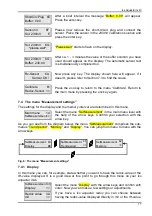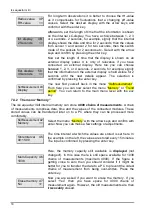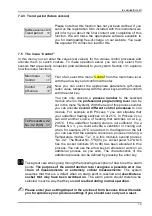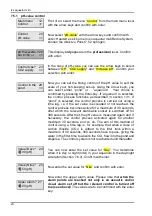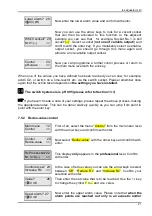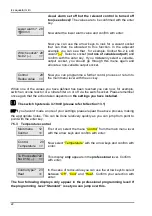
iks aquastar midi
7
Make sure that you activate the control mode when you operating automatic
monitoring and control
(see below)!
In addition, the system values are shown (rolling, when desired) on the display (date, time,
measurements, socket panel - see below). This is your
iks aquastar's
standard
operational mode. Ensure that you activate its automatic monitoring and control
(see below)!
Several keys have special functions depending on the menu you are in at a particular
moment:
esc
(abbreviation of “escape”) - normally used to interrupt or cut off a sub-menu or an
input. It is useful for when you have lost track of where you are or if you have entered
incorrect data.
×
,
Ø
You can move around on a menu level by using these ‘‘arrow keys‘‘ (left/no,
right/yes). Arrow symbols in the lower right-hand corner of the display indicate that
you can make another selection with the arrow keys. You can also get to a particular
position on the data-input mask when entering multidigit numerical values.
Ù
,
Ú
These ‘‘arrow keys‘‘ (up/+, down/-) enable you to enter numbers. You can increase a
number with
Ù
and reduce it with
Ú
. These keys are also for entering prefixes (+/-).
del
This key enables variable-output sockets to be activated directly with the set output
when testing. This key is also required for resetting. You can find out more about this
in the appropriate sections.
Ù
,
Ú
,
del
By pressing these keys simultaneously, you can adjust the contrast to the
maximum at any time.
enter-
the most familiar computer key. It is also referred to as the “return key”. You use
this to make a selection or confirm your entry.
In future you will often be asked to which socket you would like to allocate a certain
function (Which socket?). The image “
(--)
” on the display shows you that the selected
socket has not yet had a function allocated to it.
The Power Station switch socket has the number ‘‘0‘‘(L0)!
The following abbreviations show which functions are to be found in an already
occupied
socket
or which appear on the display when setting the appropriate sensor:
EA
=
External alarm
IF
=
Interval function
Ti
=
Timer
Li
=
Light (Day/night simulation:
please don't connect HQI or HQL lamps to
variable output sockets
!)
Cu
=
Current simulation
Mo
=
Lunar phase simulation (
please don't connect HQI or HQL lamps to
variable output sockets
!)
!
)
Sol
=
(Calibration-) solution
mV
=
Millivolts
pH
=
pH-value
Summary of Contents for aquastar midi
Page 25: ...iks aquastar midi 25 Notes ...
Page 54: ...iks aquastar midi 54 14 Notes ...

















